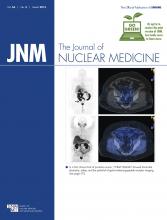Amyloid imaging in dementia: Frey provides perspectives on key questions about the utility of amyloid imaging in dementia diagnosis and previews an article in this issue of JNM on 18F-florbetapir PET in this setting.
Page 331
99mTc-MAA uptake before radioembolization: Ilhan and colleagues evaluate variations in 99mTc-macroaggregated albumin uptake in primary and secondary liver tumors before 90Y radioembolization in a large and diverse cohort of oncology patients.
Page 333
Personalized radioembolization in PVT: Garin and colleagues investigate the effects of a personalized dosimetry and intensification concept on response and survival rates in patients with hepatocellular carcinoma portal vein thrombosis treated with 90Y-loaded glass microspheres.
Page 339
DOTATATE PET in meningiomas: Rachinger and colleagues report on a study correlating 68Ga-DOTATATE uptake on PET, somatostatin receptor 2 expression, and histology (including tumor-free scar tissue) in patients with primary or recurrent meningiomas.
Page 347
PET and CRPC response: Yu and colleagues describe the results of a trial exploring the ability of 18F-fluoride PET to delineate treatment response to dasatinib in castrate-resistant prostate cancer bone metastases and to predict progression-free survival.
Page 354
Integrin PET imaging of renal masses: Withofs and colleagues identify correlations between uptake of 18F-FPRGD2, an RGD peptide, and both integrin αvβ3 expression and angiogenesis in renal tumors.
Page 361
Quantification of 18F-fluorocholine uptake: Verwer and colleagues use pharmacokinetic modeling to validate the application of simplified methods for quantification of 18F-fluoromethylcholine uptake in routine clinical PET imaging.
Page 365
18F-bombesin PET/CT in prostate cancer: Sah and colleagues detail a study of the feasibility, safety, tolerability, and dosimetric and imaging properties of the bombesin analog BAY 864367 for PET/CT in a small patient group with primary and recurrent prostate cancer.
Page 372
PET/CT acquisition timing in neurofibromatosis: Chirindel and colleagues compare the effectiveness of early and delayed 18F-FDG PET/CT imaging in differentiating malignant peripheral nerve sheath tumors from benign neurofibromas in patients with neurofibromatosis type 1.
Page 379
18F-florbetapir PET in FTD and AD: Kobylecki and colleagues describe a PET study using 18F-florbetapir PET to assess amyloid β in healthy controls and patients with frontotemporal dementia and Alzheimer disease.
Page 386
Mapping brain α2 adrenoceptors: Nahimi and colleagues determine blood–brain clearances, volumes of distribution, and receptor availability in PET with 11C-yohimbine, a selective α2-adrenoceptor antagonist, in healthy men.
Page 392
Prefrontal hypometabolism in AD: Klupp and colleagues use 11C-PiB and 18F-FDG PET and MR imaging to explore locoregional and remote relationships between prefrontal metabolism and longitudinal amyloid increase, illuminating linking mechanisms between pathology and dysfunction in Alzheimer disease.
Page 399
68Ga-EDTA PET–assessed GFR: Hofman and colleagues compare agreement between glomerular filtration rates derived from 51Cr-EDTA plasma clearance and from 68Ga-EDTA PET/CT camera-based renal imaging and quantitation of clearance of activity from blood and its appearance in the urine.
Page 405
68Ga-pentixafor dosimetry: Herrmann and colleagues detail whole-body distribution and radiation dosimetry of this promising PET tracer for imaging expression of the human chemokine receptor 4 in a small group of patients with multiple myeloma.
Page 410
Clinical evaluation of single-echo ZTE: Delso and colleagues assess a novel, recently published method for zero-echo-time–based MR bone depiction and segmentation in the skull that could be used to provide high-resolution maps of bone tissue with anatomic accuracy.
Page 417
PET/MR-based attenuation correction: Cabello and colleagues present a fully automatic method to estimate attenuation correction maps for quantitative PET reconstruction, including bone tissue, using only MR information.
Page 423
18F-fluoride PET/MR in foot pain: Rauscher and colleagues compare the quality and diagnostic performance of 18F-fluoride PET/MR imaging with that of 18F-fluoride PET/CT in patients with foot pain of unclear cause.
Page 430
PET and MR in gynecologic cancer: Lee and colleagues provide an educational overview of the complementary roles of pelvic MR imaging and 18F-FDG PET/CT in the care of gynecologic cancer patients and the potential of PET/MR imaging this setting.
Page 436
Cerenkov imaging for therapy monitoring: Timmermand and colleagues investigate Cerenkov luminescence imaging as a tool for deriving key dosimetric parameters in radionuclide therapy in ex and in vivo animal studies.
Page 444
Imaging tumor-associated monocytes: Becker and colleagues assess alarmin S100A9, implicated in induction of tumor-associated macrophages and myeloid-derived suppressor cells, as a molecular imaging marker for activity of tumor-associated immune cells in a murine breast cancer model.
Page 450
PET and MR in post-MI assessment: Lautamaki and colleagues use multiple tomographic imaging techniques to explore cardiac sympathetic neuronal pathology after myocardial infarction in a porcine model.
Page 457
Dynamic myocardial innervation analysis: Giorgetti and colleagues describe a 3D approach with a cadmium-zinc-telluride camera to clarify the normal myocardial kinetics of 123I-MIBG over time in an animal model.
Page 464
Ultra-high-sensitivity mouse SPECT: Ivashchenko and colleagues detail the development and potential applications of a dedicated ultra-high-sensitivity pinhole SPECT apparatus with very fast time resolution and the capability to image submegabecquerel tracer amounts.
Page 470
Parallel-cone collimator for SPECT: Beijst and colleagues present a parallel-hole collimator with cone-shaped holes, designed to limit collimator penetration while preserving resolution and sensitivity in SPECT imaging using high-energy photon-emitting isotopes.
Page 476
In vivo pH detection by Cerenkov imaging: Czupryna and colleagues report on the design, testing, and in vivo application of pH-sensitive contrast agents designed specifically for Cerenkov imaging.
Page 483
18F-FPEB via an iodonium ylide: Stephenson and colleagues describe a 1-step, regioselective, metal-free 18F-labeling method that uses a hypervalent iodonium(III) ylide precursor to prepare 18F-FPEB for PET imaging.
Page 489
- © 2015 by the Society of Nuclear Medicine and Molecular Imaging, Inc.







